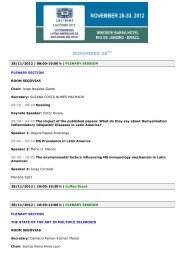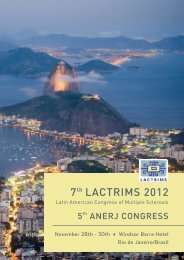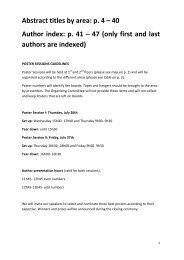Keynote Conference - Interevent
Keynote Conference - Interevent
Keynote Conference - Interevent
You also want an ePaper? Increase the reach of your titles
YUMPU automatically turns print PDFs into web optimized ePapers that Google loves.
Symp#32 Unconventional organelles<br />
Chair Marlene Benchimol<br />
Reductive evolution and the minimal mitochondria of microsporidian parasites<br />
Martin Embley<br />
Institute for Cell and Molecular Biosciences, The Medical School, Newcastle University, UK NE24HH<br />
Microsporidians are important human pathogens causing chronic diarrhoea in children and the elderly, and infecting<br />
immunocompromised patients, including those with HIV/AIDS. In addition to their medical importance, microsporidians have<br />
become models for understanding cellular and genomic reduction in eukaryotes. The adoption of an obligate intracellular lifestyle<br />
has allowed them to lose metabolic pathways and to simplify the structures and functions of cellular organelles. In my talk I will<br />
discuss how such reductive evolution has affected the proteome and functions of their minimal mitochondria – now widely referred<br />
to as mitosomes, and why, despite their reduced nature mitosomes are still essential for parasite viability.<br />
An unconventional organelle: the hydrogenosome<br />
Marlene Benchimol<br />
Universidade Santa Úrsula, Laboratório de Ultraestrutura Celular - Rio de Janeiro - Brazil<br />
Hydrogenosomes are spherical or slightly elongated organelles found in non-mitochondrial organisms. Like mitochondria<br />
hydrogenosomes: (1) are surrounded by two closely apposed membranes and present a granular matrix: (2) divide in three different<br />
ways: segmentation, partition and the heart form; (3) they may divide at any phase of the cell cycle; (4) produce ATP; (5) participate<br />
in the metabolism of pyruvate formed during glycolysis; (6) present a relationship with the endoplasmic reticulum; (7) incorporate<br />
calcium; (8) import proteins post-translationally; (9) present cardiolipin. However, there are differences, such as: (1) absence of<br />
genetic material, at least in trichomonas; (2) lack a respiratory chain and cytochromes; (3) absence of the F0- F1 ATPase; (4) absence of<br />
the tricarboxylic acid cycle; (5) lack of oxidative phosphorylation; (6) presence of peripheral vesicles. Hydrogenosomes are considered<br />
an excellent drug target since their metabolic pathway is distinct from those found in mitochondria and thus medicines directed to<br />
these organelles will probably not affect the host-cell. The main drug used against trichomonads is metronidazole, although other<br />
drugs such as β-Lapachone, colchicine, Taxol, nocodazole, griseofulvin, cytochalasins, hydroxyurea, among others, have been used in<br />
trichomonad studies, showing: (1) flagella internalization forming pseudocyst; (2) dysfunctional hydrogenosomes; (3)<br />
hydrogenosomes with abnormal sizes and shapes and with an electron dense deposit called nucleoid; (4) intense autophagy in which<br />
hydrogenosomes are removed and further digested in lysosomes.<br />
Dynamic control of the contractile vacuole complex and acidocalcisomes and their functional role in the mechanisms of regulatory<br />
volume decrease in Trypanosomatid parasites<br />
Kildare Miranda 1<br />
Wendell Girard-Dias 1 , Wanderley de Souza 1 and Roberto Docampo 2 , 1 Biophysics Institute, Federal University of Rio de Janeiro, 2<br />
University of Georgia<br />
Understanding mechanisms involved in osmoregulation control in protozoan parasites has been a challenge for many research<br />
groups. Among these mechanisms, a cyclic AMP (cAMP) signaling pathway has been shown to play a key role in osmoregulation,<br />
through a mechanism that involves the activation of an unusual organelle named the contractile vacuole complex (CVC). In<br />
Trypanosoma cruzi, the CVC is formed by a central vacuole surrounded by interconnected tubules that undergo dynamic changes<br />
upon osmotic stress and interacts with acidocalcisomes, whose structural organization, chemical properties and physiological activity<br />
may also vary upon events of osmotic stress. Biochemical and molecular data have shown that the sequence of events that take<br />
place in cells submitted to hyposmotic stress leads to an increase in cAMP levels, stimulating the traffic of an aquaporin from<br />
acidocalcisomes to the CVC through a fusion mechanism. Acidocalcisomes contain basic amino acids and high levels of cations and<br />
polyphosphate, a content that once released within the contractile vacuole, leads to an increase in the osmotic pressure towards the<br />
lumen of the organelle, stimulating water transport into the CVC. Functional analysis of mutant parasites that overexpress enzymes<br />
involved in the control of cAMP levels showed alterations in the regulatory volume decrease (RVD), a large and functional CVC and<br />
were more efficient in volume recovery. Taken together, our data show dynamic changes in the osmoregulatory system of T. cruzi,<br />
governed by signaling events that involve a unique mechanism of interaction of the CVC with acidocalcisomal components.<br />
Cell biology of magnetotactic bacteria and their organelles: the magnetosomes<br />
Ulysses Lins<br />
Instituto de Microbiologia, UFRJ, Centro de Ciências da Saúde, Bloco I, Avenida Carlos Chagas Filho, 373 - 21941-902, Rio de Janeiro,<br />
RJ, Brasil<br />
Historically prokaryotes have been described as simple cells with organization principles distantly related to the more complex<br />
eukaryotic cells. Recent advances in understanding the cell biology and molecular mechanisms underlying the ultrastructural<br />
organization of bacterial cells have modified the traditional views used to distinguish eukaryotic from prokaryotic cells. The<br />
complexity of prokaryotic cells and their similarities to eukaryotes is highlighted by the discovery of cytoskeleton elements in bacteria<br />
and further by the description of membranous organelles with specialized functions in a number of prokaryotic species. One of these<br />
organelles, the magnetosome, consists of a nanometer-sized magnetic crystal which is formed in the bacterial cell cytoplasm inside a<br />
bilayer lipid vesicle containing a unique set of proteins. The magnetosomes are organized as chains within the cell and are<br />
surrounded by a distinct cytoskeletal network of filaments. Bacteria that produce magnetosomes are called magnetotactic bacteria<br />
because of their ability to orientate and navigate along magnetic field lines which is a consequence of the magnetic moment<br />
generated by the chains of magnetosomes. The specific proteins expressed by the cell in the magnetosome membrane modulate the<br />
biomineralization of the magnetic crystals within the magnetosome vesicle. Consequently, the controlled biomineralization process<br />
that takes place in magnetosomes produce magnetic crystals with unique morphologies that is dependent on the magnetotactic<br />
bacterial species.<br />
84





